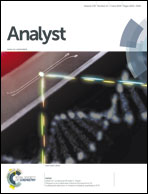A protein-based electrochemical biosensor for detection of tau protein, a neurodegenerative disease biomarker†
Abstract
A protein-based electrochemical biosensor was developed for detection of tau protein aimed towards electrochemically sensing misfolding proteins. The electrochemical assay monitors tau–tau binding and misfolding during the early stage of tau oligomerization. Electrochemical impedance spectroscopy was used to detect the binding event between solution tau protein and immobilized tau protein (tau–Au), acting as a recognition element. The charge transfer resistance (Rct) of tau–Au was 2.9 ± 0.6 kΩ. Subsequent tau binding to tau–Au decreased the Rct to 0.3 ± 0.1 kΩ (90 ± 3% decrease) upon formation of a tau–tau–Au interface. A linear relationship between the Rct and the solution tau concentration was observed from 0.2 to 1.0 μM. The Rct decrease was attributed to an enhanced charge permeability of the tau–tau–Au surface to a redox probe [Fe(CN)6]3−/4−. The electrochemical and surface characterization data suggested conformational and electrostatic changes induced by tau–tau binding. The protein-based electrochemical platform was highly selective for tau protein over bovine serum albumin and allowed for a rapid sample analysis. The protein-based interface was selective for a non-phosphorylated tau441 isoform over the paired-helical filaments of tau, which were composed of phosphorylated and truncated tau isoforms. The electrochemical approach may find application in screening of the early onset of neurodegeneration and aggregation inhibitors.


 Please wait while we load your content...
Please wait while we load your content...